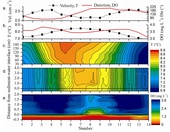Highlight
Highly Variable Sediment Oxygen Uptake Rate
Achievement/Results
Virginia Tech environmental engineering doctoral candidate Lee Bryant, her advisor Dr. John Little and a team of researchers at the Swiss Federal Institute for Aquatic Science and Technology (Eawag) have revealed that sediment uptake rates of dissolved oxygen (DO) are much more dynamic than previously thought. Quantifying the sediment uptake rate (SUR) of DO provides great insight into key sediment biogeochemical processes (e.g., organic matter mineralization, biological respiration and re-oxidation of reduced chemical species) that frequently control DO depletion in water bodies. Hence, the findings by Bryant et al. (2009) have significant implications for accurately characterizing the DO balance and corresponding ecological health of an aquatic system, which is particularly crucial in light of the pending global warming crisis and expected escalation in DO depletion rates.
Frequently, single SUR measurements evaluated under conditions assumed constant are extrapolated to characterize a lake or reservoir, thus ignoring the effect of variable environmental processes. By resolving the influence of wind-induced internal waves on the vertical distribution of DO and temperature across the sediment-water interface (Figure 1) and corresponding SUR over a very rapid time scale (Figure 2), Bryant et al. (2009) show that using isolated SUR measurements may be insufficient, especially in systems affected by high levels of variable turbulence. During this study, SUR was observed to change significantly over a period of less than an hour; thus, results emphasize (1) the control that natural turbulence has on SUR and conditions at the sediment-water interface and (2) the importance of taking multiple SUR measurements over a meaningful time period to properly characterize DO consumption and trophic conditions in aquatic systems.
Address Goals
This research, which integrates the fields of limnology, aquatic physics, biogeochemistry, soil science, microbiology and environmental engineering, was performed during an international EIGER (Exploring Interfaces through Graduate Education and Research) internship, funded by NSF IGERT (Integrative Graduate Education and Research Traineeship), that Ms. Bryant performed at Eawag during 2007-2008. During this EIGER internship, Ms. Bryant worked extensively with Dr. Wüest (head of the Surface Waters Department and leader of the Aquatic Physics group) and other members of the Aquatic Physics group to elucidate the impacts of wind-driven periodic turbulence on sediment-water fluxes. She also worked with Dr. Wehrli, leader of the Aquatic Geochemistry group, to characterize DO profile data as a function of Monod-kinetics with the aquatic system numeric modeling program AQUASIM (Brand et al. 2009). Furthermore, as part of a companion study, Ms. Bryant worked with Dr. Büergmann, leader of the Microbial Ecology group, to analyze changes in the sediment microbe community structure in response to variable DO conditions at the sediment-water interface. The NSF IGERT program has thus provided Ms. Bryant with an invaluable opportunity to perform significant and highly interdisciplinary research and to build collaborations with scientists from diverse backgrounds on an international level.







